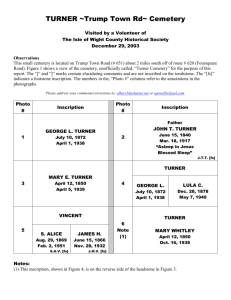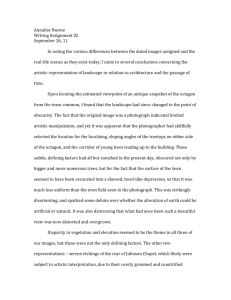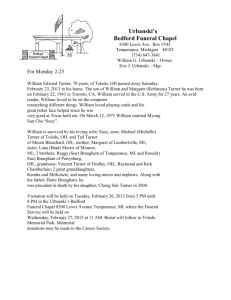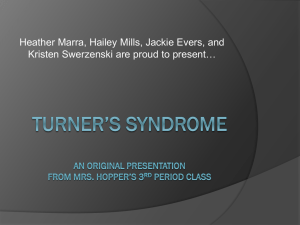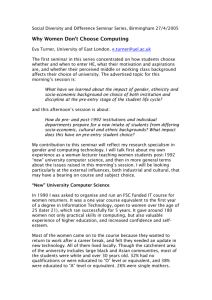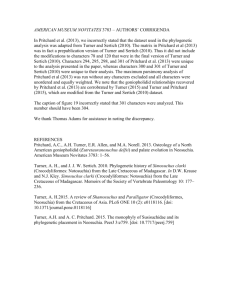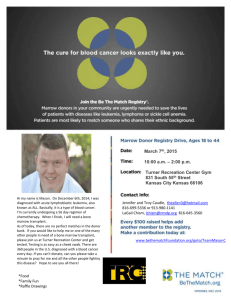William Barwell Turner (1845 – 1917): life - Microscopy-UK
advertisement
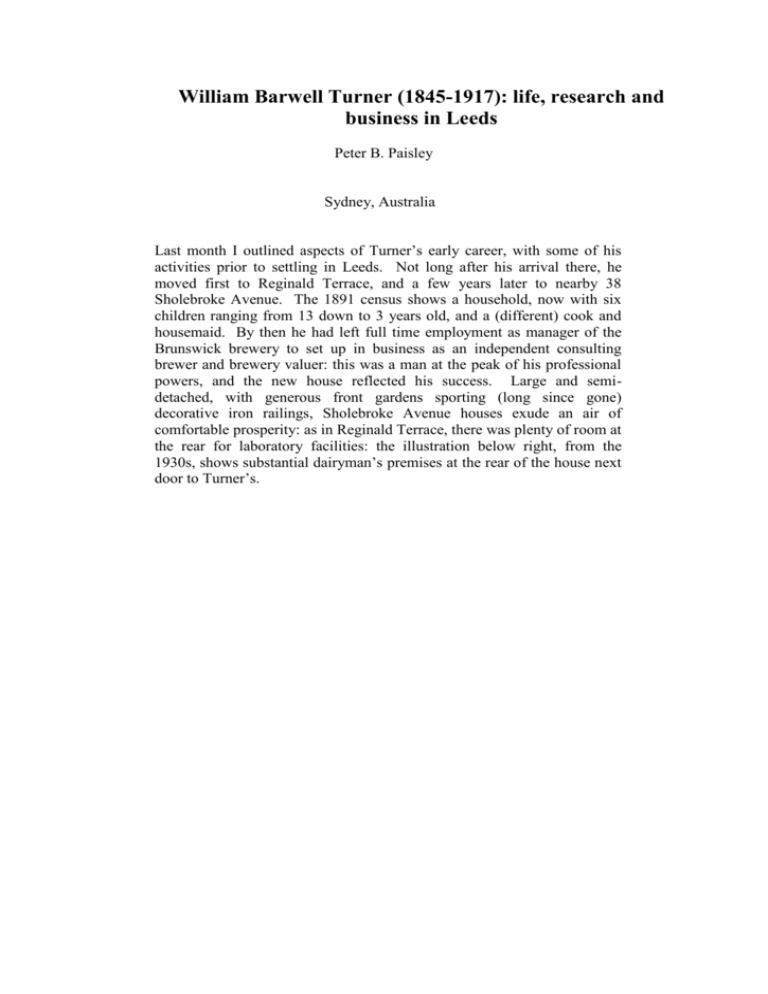
William Barwell Turner (1845-1917): life, research and business in Leeds Peter B. Paisley Sydney, Australia Last month I outlined aspects of Turner’s early career, with some of his activities prior to settling in Leeds. Not long after his arrival there, he moved first to Reginald Terrace, and a few years later to nearby 38 Sholebroke Avenue. The 1891 census shows a household, now with six children ranging from 13 down to 3 years old, and a (different) cook and housemaid. By then he had left full time employment as manager of the Brunswick brewery to set up in business as an independent consulting brewer and brewery valuer: this was a man at the peak of his professional powers, and the new house reflected his success. Large and semidetached, with generous front gardens sporting (long since gone) decorative iron railings, Sholebroke Avenue houses exude an air of comfortable prosperity: as in Reginald Terrace, there was plenty of room at the rear for laboratory facilities: the illustration below right, from the 1930s, shows substantial dairyman’s premises at the rear of the house next door to Turner’s. Houses in Sholebroke Avenue, and their rear aspects The compleat naturalist After roaming widely as a consultant brewing chemist, Turner’s geographical fixity in Yorkshire, at Woodlesford, then Leeds, yielded redoubled slide mounting activity. General microscopical interests continued, but he increasingly concentrated on specific research foci. The immediate local environment offered opportunity for original studies on fresh water algae: for instance, he carried out studies in the nearby Adel dam and Adel bog. The choice was appropriate for a brewing chemist Adel dam originally served a corn mill. The fruits of excursions to Adel Family involvement in collecting and mounting seems evident, since the annotation “with W & CT” on the Adel dam slide almost certainly indicates his two eldest children, William and Cecil. Cecil, like his father, joined the Leeds Naturalists’ Club, and in due course became one of its secretaries. Despite a career in industry, Turner senior embraced the “great outdoors” from boyhood. Rambles to places like Adel and Allwoodley could satisfy both his love of rural environments and his passion for collecting specimens, and visits further afield in Yorkshire to coastal settlements like Filey Brigg or Trellick likewise provided material for study, exemplified by the slides illustrated below. Out and about, collecting material, from urban rural adjuncts to wilder seashore locations Algae were attractive to someone with broad interests. Ranging from giant oceanic kelps over two hundred feet long down to desmids only visible through a microscope, and ancient in evolutionary terms but with thousands of extant species, they must have seemed an investigative wonderland. Fresh water species were a major interest but marine algae were not ignored: I imagine few visits to the seaside passed without specimen gathering, and the results produced many mounts. As his late work shows (more of this in my next article), Turner was comprehensively versed in the literature, and mounts usually carry precise identifications. Some marine algae by Turner Algae generally were mounted in great numbers, and he became an authority on these, but his vision was never narrow. An expert shot from early boyhood, his interest in game birds perhaps led him to study avian parasites in general, and a selection is shown below. The whole natural world, it seems, was his oyster, and he took a delight in examining as much of it as he could through his microscope. The range of slides he made rivals that of many a commercial mounter. The examples below convey some idea of his breadth of interests. Just some of the subjects which caught Turner’s attention From boyhood, Turner made mounts: roaming far and wide as a consultant chemist, he further developed his skills. It is difficult to imagine him doing so without a microscope, as indispensable as a small hammer to an itinerant geologist. From at least 1857, the Kensington Natural History Museum was urging schools to acquire scientific equipment, including microscopes: a catalogue was issued by their educational department indicating where they could be obtained. From the 1857 museum catalogue: the school equipment above could be obtained from the J.J. Griffin company While he was at school the leading Birmingham makers were Robert Field and Son: they exhibited at the Great London Exhibition of 1851 – without attracting much praise: but in 1855 they won the Society of Arts prize for a handsome instrument whose design was rapidly copied by other firms. The prizewinning Field & Son instrument While it is possible that Turner had access to such a model at home (his inlaws the Barwells were comparatively well off) his earliest introduction to microscopy was probably via more modest instruments at King Edward’s Grammar School. Field & Son supplied Birmingham schools with reasonably cheap junior instruments, witness the advertisement below. Somewhat later, Washington Teasdale designed a small model for Field & Son, designed to be outdoor portable: Field & Son claimed this as the first such “field microscope”, a somewhat whimsical pun. I like to think Turner may have owned a Teasdale designed instrument at some stage, and carried it with him on specimen gathering forays. What is certain is that he knew Teasdale when both were Leeds residents, since both belonged to the Leeds Naturalists’ Club, the Yorkshire Naturalists’ Union and the RMS. Turner applied his chemical expertise widely. In an article in the Yorkshire Weekly Post, written the year before he died, he reminisced on his early days. Highly critical of the competence of English agriculture, he bemoaned the fact that advances in chemistry were resisted by many farmers. As his article says, agriculture “for long past has been in the hands of quacks and empirics”. Turner made many friends among the aristocracy, largely in connection with his interest in heraldry: most had widespread landholdings, and it seems likely that he offered them advice on soil improvement. Among them was Henry, first Viscount Chaplin, who had holdings in Yorkshire, and an agricultural cabinet post in government. As Turner’s obituary appreciation says, he was “fit to associate with the famed Squire of Blankney” (as Chaplin was commonly known). . The Squire of Blankney – one of Turner’s more colourful friends - in a Punch cartoon Chaplin once received a deputation on the problem of swine fever: Turner’s pungent criticisms echo the Punch view of farmers’ abilities. Probably Turner’s broad experience of applied chemistry propelled him naturally towards an equally broad approach to microscopy, amply evidenced by his wide ranging mount output. He joined the Leeds Naturalists’ Club in 1876, bringing dual expertise to its ranks. The Leeds Naturalists’ Club Turner’s first year produced no papers for the club on microscopy (or anything else). Matters elsewhere were significant - in 1877 he returned to Bruton, in Somerset, to marry Mary Emma Jones in the Anglican parish church of St. Mary the Virgin, on June 26th. His stay possibly lasted a month or more – the full banns of marriage were proclaimed over three weeks: the honeymoon may have been at the pleasant coastal resort of Weymouth, on the coast not far from Bruton and easily accessible by rail. In previous years he probably combined chemical consultancy at William Devenish’s Weymouth brewery with his other work at nearby Bruton. Slides made in the west country 1874 - 1876 Mary Emma was the main attraction to Bruton and Weymouth, but that did not stop Turner keeping abreast of the literature. The slide above right, made in Bruton when Turner was with his future in-laws, is interesting: dendritic spots on paper were hardly a mainstream subject for most microscopists. However, Chemical News (June 18, 1874) reported disagreement on whether the [purely chemical] marks were due to poor quality paper, or contamination from printing machinery, and on their chemical nature. Others had long taken a different view, regarding the spots as fungal contamination. Science Gossip (April1969) which Turner may have already read, had a lengthy editorial discussion on the spots by M.C. Cooke. Cooke favoured the inorganic explanation, but debate continued among microscopists. Turner, handy with both microscope and test tube, investigated for himself (what conclusions he reached, I do not know). When Turner joined the Leeds Naturalists’ Club, he brought an ever inquiring mind, long since reaching in many directions. Club records available on-line are frustratingly fragmentary – for instance it seems impossible to establish exactly when Turner became president (the Yorkshire Weekly Post as long ago as 1917 was only able to give the approximate year of 1881). Probably record publishing was pretty sporadic, as the note (above) to Charles Pagan, assistant secretary to the British Museum of Natural History, suggests – an impression reinforced by the fact that Science Gossip reported on the Club’s early activities, whereas in the 1880s there is little mention of it. What is available shows that Turner played a lively part in its activities. He gave his first paper in January 1878, on Matters used in the permanent preparation and examination of microscopic subjects. In 1877, the club’s president was James Abbott, with whom Turner formed a working relationship, since they combined in making mounts. Turner’s next paper, on general mounting and staining techniques, as one might expect from an analytical chemist, describes detailed compositions of various preserving, mounting and ringing media. Turner constantly encouraged other club members to foster microscopic applications of their work, whatever the subject. As his obituary appreciation comments, He was the guiding spirit of its microscopical section, particularly with regard to the study of pond life. In Abbott’s case, there was little need for persuasion, since he was already a competent mounter. Their interests overlapped in other ways too: Abbott was a pharmacist, so they had matters chemical in common. The illustration below shows two slides by Abbott, and three probably by Turner made from material supplied by Abbott. Illustrating the Turner/Abbott collaboration Other members of the club included John Dixon of the Leeds General Infirmary, Frederick Greenwood, Curator at the Leeds School of Medicine, and James Loe, a surgeon. Doubtless such colleagues, directly or indirectly, could furnish Turner with human tissues, enlarging his mounting repertoire. The spinal cord mount above, and four further examples shown below, are likely results of such collaborations. Yorkshire was replete with naturalists’ clubs: to name a few, they existed at Selby, York, Keighley, Wakefield, Huddersfield, Bradford, Barnsley, Richmond and Doncaster. Leeds had various kindred associations such as its Philosophical and Literary Society, and a Mechanics Institute where the Naturalists’ Club held some meetings. Turner devoted much energy to involving them in correlating and communicating their diverse activities. Elected Fellow of the Royal Microscopical Society in 1879, he was probably the club’s only FRMS president since Henry Pocklington. It was not long before his researches on algae in the Leeds region bore local fruit, and in 1879 the Club published his Catalogue of the Freshwater Algae of the Leeds District. In 1885, he brought three foreign works on algae for examination by the club, and in May that year he gave a paper on desmids, on which by then his attention had become strongly focussed: in September he exhibited slides of rare desmids, described in the club’s report as “very beautiful”. In the same year, he published his findings – On some rare and new desmids – in the Journal of the Royal Microscopical Society (series ii, v, part 1, p.933). The Leeds Club also published a list of known west Yorkshire algae: Turner was one of its compilers, although – at that time oddly, for him – the list in question excluded diatomaceae. Wider horizons: the Yorkshire Naturalists’ Union An umbrella organisation for many if not most of the natural history clubs scattered through the county, the Yorkshire Naturalists’ Union reported member clubs’ activities and publications. In their botanical report of 1878 on algae, it was remarked The workers in this field are few…..the want of a recent British manual of the fresh water algae being a great impediment in the way of their study. Turner subscribed to the Union: by 1880 it noted his work on Leeds district algae. It also listed eleven algae not previously reported for Yorkshire, and Turner’s work was responsible for nine. Before this, the Union’s 1879 lepidoptera report contained a long list of observed species: the majority of the observations – no less than 57 – bore Turner’s name, always in cooperation with two of his Leeds colleagues, Abbott and Emsley. He was a most congenial naturalist. I have already remarked on his friendship with the eminent lepidopterist Lord Walsingham (a leading light in the Union): his collaboration with the two other Leeds Club naturalists resulted in many of Turner’s composite slides. Eight of the species recorded by the Yorkshire Naturalists’ Union are represented in the two slides above Given his prolific algal mounting around this time – not to mention full time business occupation - Turner’s additional activities out and about observing Lepidoptera are remarkable. This is especially so given that ill health increasingly troubled him. An independent businessman Moving to solo enterprise in the 1870s or 80s was by no means without risk. Turner’s wide experience as a brewing chemist, coupled with knowledge of the industry over a wide part of England, placed him well as a valuer. In addition, he secured a place in the Leeds Corn Exchange. As in any exchange, activity there could be frantic, with many buyers and sellers competing for the best deals on offer from grain stock displayed under good light on the floor, and clear visibility was ensured by the specially designed elliptical glass roof. The corn exchange, with dealers’ places on the floor When Turner was in the exchange, fallout from the panic of 1873 had not totally subsided: many economic historians rate the resulting depression affecting the USA, and much of Europe, as longer and more severe than that of the (now more familiar) “great depression” of the twentieth century. Britain by now had long been a net importer of grain, and trading in grain futures – if that was part of Turner’s business – could be hazardous. Bubbles might burst – in 1899 for instance the sale price of grain on the Chicago exchange fell to half the cost of production in Kansas. While this was an extreme example, well after Turner’s time in the Leeds exchange, lesser fluctuations could and did occur in his day, and a wrong decision on futures could be financially traumatic. Life in such a business environment required day to day concentration: it is a wonder Turner found the time and energy for so much mounting and research. A buyer’s desk from the Corn Exchange, still in beautiful condition, is shown below. In the middle and late 1880s Turner was increasingly assailed by chronic health problems: pressure of business and intense research activity continued (he was still on the council of the Leeds Naturalists’ Club in 1886). Under such circumstances something had to give. Whether or not involvement with grain futures contributed to its demise, Turner’s business was in the debtors’ lists by May 1892, and gazetted with an official receiver by December 1893. The 1901 census lists him as “retired, incapacitated”, which must have been the case for a considerable time. The family had moved to Sholebroke Place: near their former residence, but a much more modest home. Houses there lacked gardens, and compared to Sholebroke Avenue, were terraced, small and densely packed. No longer were servants present: presumably the three boys – William, Cecil and Geoffrey – sustained the family financially. Despite illness and financial problems, Turner remained active: no longer able to roam far and wide collecting material, he nevertheless served on the editorial board of The Naturalist, which published material submitted by societies all over the north of England. An advertisement appearing regularly throughout 1901 in Science Gossip (new series), when Turner’s health and financial problems were significant Arms and the man Many slides, commercially made or not, bear crests or monograms of the makers or owners. Some have simple initials, some are more elaborate, with mottos. They vary from clear initials to more complex designs, some of which defy decryption. The owner of the slides above did not make monogram interpretation easier with each variation! Due to the thickness of the mount, the slide on the left is showing its monogram out of focus, but it is identical to that described by Bracegirdle as “quite indecipherable” (Microscopical Mounts and Mounters, plate 42 K). The three all have the same initials, probably PRA, but double letter superimposition on the example above left (and in Bracegirdle) beckons psychiatric help rather than calligraphic improvement. By contrast, analysis of Turner’s monogram is rewardingly revealing. Few if any slide monograms show derivation from authentic heraldry Turner’s is rare, if not unique, in this respect. He is known to have done extensive heraldic research in his retirement years, and Thoresby Society library material includes much of this. The Yorkshire Weekly Post appreciation claims him as “one of the best authorities in the kingdom”, and when King George V visited Leeds University in 1915 he showed great interest in Turner’s heraldic illustrations. The King may have heard of Turner from his father: Turner’s friend Chaplin, mentioned previously, was known to entertain Edward VII (and some of his mistresses) at his Yorkshire property. But Turner’s interest in heraldry and genealogy went back much further than that. As early as 1873, and possibly before, he designed a monogram combining his initials with the motto ne cede malis and the heraldic device of a lion passant holding a fer de moulin (a mill-rind) in its dexter paw. The fer-de-moulin is on many Turner coats of arms from England, Ireland and Scotland, appearing on escutcheons sometimes multiple times. The combination of motto and lion (which seems to lack a crown) narrows the field to two or three English branches, and our Turner may have traced his ancestry to a relationship with one of these. An illustrious namesake, William Turner the herbalist, active during the times of Henry VIII, Mary and Elizabeth I, is regarded as one of the founding fathers of English botany, which almost certainly increased W.B. Turner’s interest, since Linnaeus named the genus turnera after him, and an entire order, by W.B. Turner’s day, was named turneracea – such nomenclature could hardly escape the curiosity of our botanising mounter. Some monogrammed Turner slides Turner seems to have used his monogram sporadically: perhaps there are many more “out there somewhere”, or perhaps, with many friends in the aristocracy, he did not wish to push the impression he was related to current nobility. Whatever the case, the monogram is something of a stand-out among Victorian microscope slides. The monogram in close-up. The initials WBT may not be immediately obvious, but are relatively easy to interpret, and the heraldic elements are very clear. Grammar school education used Virgil as a standard Latin author. Turner probably remembered passages: he remained fluent in Latin, which served as a lingua franca with his many Scandinavian contacts during his desmid studies. He ascribes his decision to concentrate on these to reading a Latin paper, commenting on the author’s pleasing Latin style, and naming a species (S. Lundellii) after him, thus; To the author of the De Desmidiaceis I dedicate this little member of a family on which he has so well written. (To the chance perusal of Dr. Lundell’s memoir, in which the excellence of the descriptions is but equalled by the elegance of the Latin, I owe my commencement of Desmid-study W.B.T.) (W.B. Turner, Algae Aquae Dulcis Indiae Orientalis: The Fresh Water Algae, Principally Desmideiae, of East India, p.131) Most annotations in Turner’s book are bilingual, confirming his Latin skills - something one could not discern from looking at his slides, and a dimension making him more interesting. In addition, I believe the motto had special poignancy. Turner’s health woes were more complex than the varicose veins stipulated by his obituary appreciation. Virgil (Anaeid bk.vi, at the end of the Sybil’s prophecy) wrote tu ne cede malis sed contra audientor ito – yield not to misfortunes, but go on more bravely. For someone so energetic, increasing physical restriction would have been distressing, so the motto indicates a resolve to persevere. A committed evolutionist Comments in Turner’s book quoted above (I abbreviate it hence to “Algae”) reveal his position on evolution. His collaborator George Charles Wallich had probably been won over by Chambers’ Vestiges of the Natural History of Creation, a book which set the scientific world buzzing with controversy for decades. Turner says (Algae, p. 93) From Dr. Wallich’s remarks…….it appears that between 1854 and 1860 he had become an enthusiastic evolutionist This indicates an increasing commitment, surely due to Vestiges and then presumably consolidated by reading Darwin. Turner says (Algae, p.6) I cannot but help agree for the most part with Wallich [who said] the law which it is assumed governs the limit of species is no law, but only a conditional direction, holding good only so long as the surrounding conditions continue the same If conditions changed, of course, so might the various species subjected to them: in short, natural selection could operate. On mechanisms for species change, Turner seems to favour the possibility of interbreeding: Algae p.93 says Both against and for the fusion of species there is much to be said: the quaestio vexata will hardly be settled, as Evolution demands generations of forms upon which to effect change, which would require generations of observers to detect and consider. This echoes Darwin and Lyell, but Turner, a brewing chemist familiar with bacteria and fungi, was aware that at that level, time frames for multiple generations were greatly accelerated by successive cultures. A little higher up the complexity scale to desmids, in at least two cases he says The truthfulness of Dr. Wallich’s remarks upon diversity of form is amply sustained In other words, microscopists working with micro-organisms did not require geological time, but could and very possibly did observe evolution in action. An adventurous conservative Turner’s obituary appreciation has this to say: He was a charming conversationalist, full and ready and accurate in his discourse, with strong but well backed-up opinions expressed with characteristic vigour……the nature of his opinions may be gathered from the fact that he was a Churchman and Conservative of the good old school of long ago Taken in isolation, this might imply religious piety favouring creationism and Paley/Bridgewater Treatise inspired opposition to evolutionary ideas, something still very much alive and kicking in his day. But such, as shown above, was not the case. Whether or not he “went the whole orang”, as Lyell put it, on human evolution I do not know. It seems not in his nature to have been combative, like Huxley – or even more so Tyndall - against the anti-Darwinists: besides, there were many like him who accommodated the new ideas within a retained religious adherence. In that context, his most relevant contemporary was William Dallinger. Both subscribed to the Yorkshire Naturalisis’ Union, Dallinger becoming its President, and it is highly likely they knew each other. Dallinger carried out controlled experiments in evolution, using bacterial cultures under variable temperatures – the experiments lasted 7 years until 1886, the year Turner was finalising his catalogue of desmids, and confirmed the very possibility hinted at in his note mentioned above. Seven years is a long time, but miniscule compared to geological epochs required for large species to undergo evolutionary change. Both Turner and Dallinger were fellows of the Royal Microscopical Society (Dallinger became its president), and Turner undoubtedly knew of his experimental evolution work, although probably not in time for inclusion in Algae. Turner, a loyal Anglican, lived through a time when the disestablishment debate was raging, at times with heated polemics. What his stance was I have not discovered, but his marriage certificate is intriguing. By this time (1877), the Anglican church had been disestablished in Ireland: more to the point perhaps, the push was still going on in Wales, close to the west country. Someone has deliberately crossed out “established” from this certificate, inserting a handwritten amendment so that the registry certificate now reads simply “church of England”. It may have been a disestablishmentarian Bruton vicar: but if the someone was Turner, he favoured separation of church and state. (Inquiries with current Bruton clergy have failed to clarify the matter). I imagine Turner was pleased to learn of Dallinger’s support of evolutionary ideas, and spirited defence of Darwin, in his Fernley Lecture to the British Methodist Conference in 1887, duly reported in Science Gossip, which was regularly received by the Leeds Naturalists’ Club. I am sure he concurred with Dallinger’s position (even if the latter was a Methodist clergyman, converted from Anglicanism!) The constant botanist All the way through his mounting career, Turner continued with general botany. As a professional brewing chemist he had appropriate interest in seeds, pollination, fructification and plant pests, but this extended beyond brewing grains, as illustrated below. By no means all Turner slides are dated, but enough are to show his botanical activity from earlier days through to his settling in Leeds. Botanising, 1873 - 1880 The slides above comment on Turner’s presentation. To paper or not to paper? It is commonly assumed that papering was being phased out by the mid 1870s, having been the prevailing fashion until then: but there are so many exceptions to this “rule” that it gets pretty ragged at the edges. Many early slides are unpapered: even when the fashion was approaching flamboyant excess, the only papered Smith and Beck slides from their first address (6, Coleman St., 1847-56) are those already papered by various mounters and on-sold with the S&B label added. Papering (and its phasing out) was a by-product of various Victorian decorative art styles, at any rate after the advent of balsam. Not everyone followed fashion: I have no idea what Turner’s wallpaper and furniture looked like, but his slides display whatever he felt like doing, regardless of fashion. Another factor probably operated: consultant chemistry took him to small towns with no optical shops, or none that sold papers. I surmise his longer stays brought papers and labels postally, probably from Birmingham. If they arrived in time, he might paper – if not, he mounted unpapered slides, with or without his personal printed labels. Mounting – a family pastime? Commercial firms – Norman, Topping, Wheeler, Suter, for example – are well documented mounting family industries. I find no evidence that Turner sold slides, but the prospect must have been tempting after he became more or less house-bound through illness, and straightened financial circumstances prevailed. Leeds had optical shops which retailed slides: the fact that at least one near him, Peniston, advertised desmid slides for sale might arouse some suspicion. An undated slide with Peniston’s retail label More significantly his friend of later years, William West, retailed slides in nearby Bradford. The Yorkshire Weekly Post obituary appreciation mentions frequent correspondence with West during Turner’s algal research: opportunity for slide sales, if that was desired, was certainly not lacking. Advertisement in Science Gossip (new series) 1901, offering slides by Tempère. Turner’s son Cecil is likely to have helped with his father’s mounting, if only through general interest, as he became a secretary to the Leeds Naturalists’ Club: the eldest son William may also have helped, since he was involved in gathering desmids. Without specimens of their handwriting one cannot speculate further (and slides with Leeds optical retail stickers do not often turn up these days.) Slide sales would have been a handy supplement to family income: all I can say is that no Turner slide I’ve seen bears a retailer’s label, but production for sale by his sons cannot be ruled out. In happier days, with a family cook and housemaid, it is probable family members joined in preparation, at least from time to time. Initials on labels Turner had a habit of including initials on his slide labels, to indicate who supplied material for his mounts. His Leeds colleague Washington Teasdale is known to have examined the microscopical properties of various inks: Turner, typically, went further and tried out red ink as a histological stain. The initials WT on the slide (left) are pretty sure to indicate Teasdale as the source of material. (“CB” of course means Canada balsam) A much more personal example of Turner’s initialling of labels exists. He made many fern mounts, often carrying Linnean annotations, and a few are shown below. In the mid Victorian era, fern collecting by young ladies became something of a craze, prompting Charles Kingsley to coin the term “pteridomania”. By the time Turner’s only daughter Bertha was born in 1882, the craze had substantially subsided – but she was not the only female in the family. In my previous article I proposed that Turner’s wife shared his interest in botany and mounting. The slide below is dated more than two years before Turner’s marriage: as in many cases, he wrote the initials of the person who gave him the material. The initials here are MEJ: they are those of his fiancée, Mary Emma Jones (the slide also bears Turner’s inscribed initials). If she was merely collecting and pressing ferns, as was common, Turner would have led her to another dimension of interest via microscopy, and that doubtless continued. Mounting may indeed have been a shared family occupation. Turner’s slides: a critical overview Were all slides which carry Turner’s labels made by him? Regarding those which bear his printed labels, I accept them as wholly by him. He was by all accounts an exceptionally honest man, who would not affix labels printed “W.B. Turner preparer” to mounts made by others. He did not collect all material himself, but was often scrupulous in adding initials of those who supplied it. Hence, any slide with his printed label (and no initials added) must be accepted as entirely Turner’s production, unless categorical evidence emerges to the contrary: and slides with his label, and initials of material suppliers, were still mounted by him. When it comes to papered slides lacking his printed labels, things are less straightforward, and may present – as he would have said – a quaestio vexata. Sometimes he added handwritten notes – but not his printed labels - to slides clearly made by others, such as Topping or Webb. In other cases, papered slides, lacking his personal label but with his handwriting on them, are equally clearly his own: a slide with his handwriting from Woodlesford, for instance, could hardly be anyone else’s, and there are many such examples from other locations where he worked. There remains a residue of some papered (and a few unpapered) slides where precise provenance is unclear. I have not attempted to steam off Turner handwritten additions from such slides, which might be revealing. Some have papers characteristically used by Webb, and others have patterns like those on “F” slides. Regarding the latter, Brian Stevenson (personal communication) suggests they may be generic papers issued by Field & Son, and I tend to agree. Given Turner’s Birmingham origins, he may well have possessed such papers, if they were indeed by Field: “F” slides, generally, do not turn up often, and bear many different handwritings – as is the case with “SB” papers (Smith & Beck) or “JA” papers (presumably Amadio). In Webb’s case, one paper pattern in particular is highly distinctive. In Algae (p.86) Turner describes Webb as A good and unassuming man, among ‘micro-mounters’ of his time facile princeps [easily the chief] Which seems to indicate he knew Webb. It therefore seems unlikely he would try to pass off a Webb slide as his own. In other cases, matters are unresolved. Much remains to be discovered. A microscopist in his times Microscopy enthusiasts in Victorian times had favourite subjects. While Turner made major contributions to research and documentation of algae, he concentrated on them quite late in his career. Insects, foraminifera and hairs from various species found their way into many a cabinet, and Turner was no exception: examples are shown below. Other common subjects for mounting included lepisma scales (often used on test slides), marine organisms, blood cells and gorgonia spicules, illustrated below. While Turner himself had broad interests – making hair mounts from many species, for instance - quite likely he also made slides for his children to study: young people interested in microscopy were aware of popular mounts, and what better than to have them supplied at home. The date 1885 on the lepisma slide is perhaps particularly suggestive in that context. The desmid specialist I have already touched on Turner’s work with desmids. These provided the basic material for what became his magnum opus, quoted above. In another article I shall correlate slides he made with entries in his book. Acknowledgements Thanks to Brian Stevenson for discussion on some papers used by Turner, and for drawing my attention to the Natural History Museum catalogue. Thanks to Eveleigh and Michael Bradford of the Thoresby Society for helpful information Thanks to Michelle Peckham of Leeds University for information on library holdings. Unfortunately, as with many institutions, efforts to obtain transcripts or jpegs were unsuccessful. Sources Wikipaedia www.ancestry.com www.leodis.net www.maps.google.au www.archive.org (Publications by the Leeds Naturalists’ Club, The Yorkshire Naturalists’ Union, and Science Gossip are available there on line) Virgil book v: umpteen translations are available, but for those interested in Latin/English comparison the Loeb Classical Library’s parallel text is recommended Thomas Robson (1830): The British Herald, or armorial bearings of the nobility and gentry (available on line via Google Books) William Barwell Turner: Algae Aquae Dulcis Indiae Orientalis, the FreshWater Algae of East India , P.A. Norstedt & Söner, Stockholm 1892. This book is rare (I have seen none on offer from antiquarian dealers): I have used the Kessinger Legacy reprint. B. Bracegirdle (1998) Microscopical Mounts and Mounters, Quekett Microscopical Club Yorkshire Weekly Post, April 18 1916 & 19 May 1917 (the 1916 article is signed only with the initials WBT) Email author: lois737 AT bigpond DOT com Published in the October 2011 issue of Micscape Magazine. www.micscape.org .
